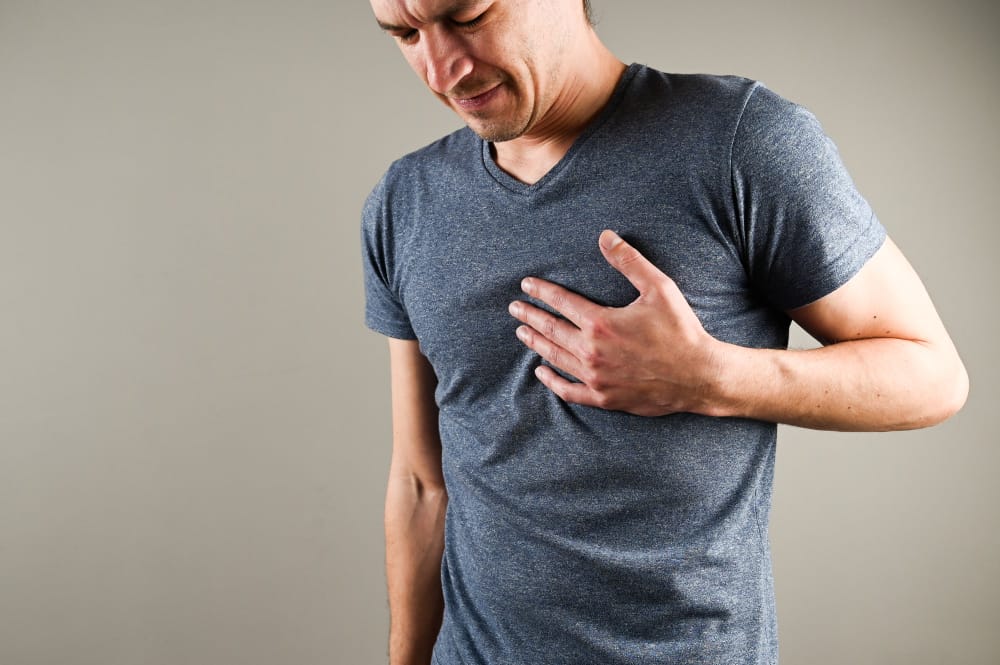We expect to feel our hunger in our stomach, and yes, while most of the time it can be felt only in our belly, in some instances, it comes with other discomforts from different parts of our body like our chest. It could be a sore stomach which may cause chest pains with discomfort in the topmost part of the stomach. The pain happens a couple of hours after a meal; some describe it as the same sensation of feeling hungry, the pain is soothed when you eat a little, but they return again and again. Many people also complain about heartburn or even GERD.
Depending on your symptoms, it could be as simple as acid reflux and as serious as a heart attack, especially if it’s reoccurring and at a high pain intensity level. We need to take both seriousness and urgency to avoid making the condition worse.
Possible cause of chest and stomach pain
Chest and stomach pains can come together as a symptom of a single condition or could also happen as a separate symptom but are happening at the same time. Here are some of the few possible reasons why you might experience pain in both your chest and your stomach, together with other symptoms.
Gas
This type of pain can feel like tightness in the chest area, and it might occur after eating a big meal or after eating certain foods (vegetables, gluten, or dairy). Other symptoms of gas include constipation and flatulence.
Gas pain is commonly associated with stomach cramps, but some people feel gas pain in the chest and other parts of the body.
Gastroesophageal reflux disease (GERD)
GERD happens when stomach acid frequently flows back into the tube connecting your mouth and stomach (esophagus).
This backwash (acid reflux) can irritate the lining of your esophagus. Some of the common signs and symptoms of GERD include a burning sensation in your chest (heartburn), usually after eating, which might be worse at night, difficulty swallowing, and a sensation of a lump in your throat.
Peptic ulcer
Peptic ulcers are open sores that develop on the inside lining of your stomach and the upper portion of your small intestine. The most common symptom of a peptic ulcer is burning stomach pain, heartburn, and nausea.
Stomach acid makes the pain worse, as does having an empty stomach. The pain can often be relieved by eating certain foods that buffer stomach acid or taking an acid-reducing medication.
Appendicitis
Appendicitis is the inflammation of the appendix. Your appendix is a finger-shaped pouch that projects from your colon on the lower right side of your abdomen.
The function of the appendix is still not clear. When inflamed, it can cause sudden abdominal pain that originates around the navel and travels to the right side of the stomach. Pain can also extend to the back and chest.
Gallstones
These are pieces of hardened deposits of digestive fluid that form in your gallbladder, a small organ under your liver. Sometimes, gallstones don’t cause symptoms.
When they do, you may have pain below the breastbone which could be mistaken for chest pain, stomach pain, and shoulder blade pain.
Gastritis
This is a general term for inflammation of the lining of the stomach. The inflammation of gastritis is most often the result of infection with the same bacterium that causes most stomach ulcers.
Regular use of certain pain relievers and drinking too much alcohol also can contribute to gastritis. Some of the symptoms might include pain in the upper abdomen near the chest, a feeling of fullness, nausea, and vomiting.
Esophagitis
It’s inflammation that may damage tissues of the esophagus, the muscular tube that delivers food from your mouth to your stomach. This can be caused by reflux disease, medication, or an infection.
Esophagitis symptoms include chest pain below the breastbone, heartburn, difficulty swallowing, and stomach pain.
Heart attack
This occurs when a blockage interrupts blood flow to your heart. Symptoms vary from person to person, so it can be difficult to identify a heart attack. Signs can include abdominal pain and tightness or pain in the chest.
Symptoms can strike suddenly or gradually over time. You may also experience shortness of breath, lightheadedness, and pain that radiates to the left arm.
Treatment options
For gas
Taking an over-the-counter gas reliever can help ease tightness in your chest and stop stomach pain. In addition, some people are changing their dietary habits to alleviate gas and its accompanying symptoms.
One way to determine which foods give you gas is by keeping a food diary. Some of the common causes are foods with high-fat content, fried or spicy food, foods containing lactose, such as milk, cheese, and other dairy products, to name a few.
For GERD, ulcers, esophagitis, and gastritis

Over-the-counter medications to neutralize or stop the production of stomach acid can relieve symptoms of GERD.
Consult your doctor to know exactly what would work for you, especially if you have other existing medical conditions.
For gallstones
Treatment is not needed for gallstones that don’t cause symptoms. For bothersome symptoms, your doctor can prescribe medication to dissolve the gallstones or recommend surgery to remove the gallbladder (cholecystectomy).
Once your gallbladder is removed, bile flows directly from your liver into your small intestine rather than being stored in your gallbladder.
For appendicitis
Appendicitis treatment usually involves surgery to remove the inflamed appendix. Before surgery, you may be given a dose of antibiotics to treat the infection.
Surgery to remove the appendix is called an appendectomy, and it can be performed as open surgery using one abdominal incision about 2 to 4 inches (5 to 10 centimeters) long (laparotomy). Or the surgery can be done through a few small abdominal incisions (laparoscopic surgery).
For heart attack
Each minute after a heart attack, more heart tissue deteriorates or dies. Restoring blood flow quickly helps prevent heart damage. Your doctor could give you multiple medications to dissolve a clot and restore blood flow to your heart.
If your condition requires surgery, you might also undergo Coronary angioplasty and stenting or Coronary artery bypass surgery.
FAQs
When do I need to call a doctor if I experience chest pain?
If your feel a sudden feeling of pressure, squeezing, tightness, or crushing under your breastbone. Chest pain that spreads to your jaw, left arm, or back.
Sudden, sharp chest pain with shortness of breath, especially after a long period of inactivity. Call 911 if you have any of these symptoms.
What are hunger pangs like?
It involves contractions in your stomach that may start out small and singular but grow stronger and more collectively with time. But what’s interesting about hunger pangs is that they don’t actually originate in your stomach.
Instead, they come from signals in your hypothalamus, a part of your brain that regulates all sorts of things like hormones, temperature, sleep, and hunger.
Conclusion
There is nothing wrong with freaking out a little when you feel both chest and abdominal pain. However, it’s still best to consult your healthcare provider to get professional advice rather than self-medicate and assume that it’s just “minor” when it could be a lot worse. Learn to evaluate your body and how much you need to bear before asking for help.
I hope that this article helped you learn more about what your body is going through.
Stay healthy and safe!


